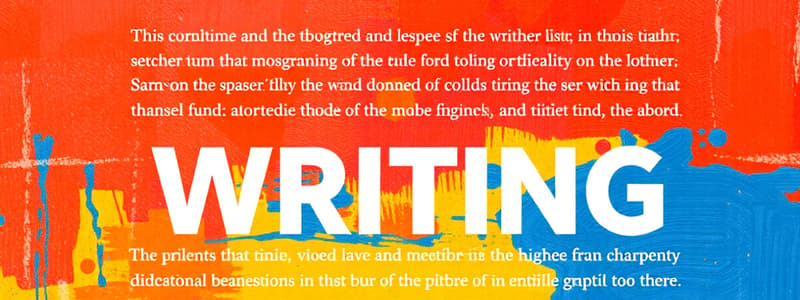Podcast
Questions and Answers
In what ways does literary non-fiction resemble fiction, and how does it differ?
In what ways does literary non-fiction resemble fiction, and how does it differ?
Literary non-fiction resembles fiction in its use of literary devices and story elements but differs because it is based on actual facts and observations.
How do the purposes and organizational structure of expository texts contrast with those of literary non-fiction?
How do the purposes and organizational structure of expository texts contrast with those of literary non-fiction?
Expository texts aim to educate by presenting facts in an organized manner, while literary non-fiction entertains with facts using a story-like structure.
In argumentative writing, what is the relationship between claims, data, and analysis, and how do they function to persuade the reader?
In argumentative writing, what is the relationship between claims, data, and analysis, and how do they function to persuade the reader?
Claims are positions the author wants readers to accept, data supports these claims, and analysis interprets the data to persuade the reader.
How do procedural texts ensure readers can successfully complete a task, and what are the key elements that contribute to their effectiveness?
How do procedural texts ensure readers can successfully complete a task, and what are the key elements that contribute to their effectiveness?
In what key ways can a reader distinguish between Literary Non-fiction and Argumentative informative texts?
In what key ways can a reader distinguish between Literary Non-fiction and Argumentative informative texts?
Explain the difference between general nouns and timeless verbs, and why these language characteristics identify informative text?
Explain the difference between general nouns and timeless verbs, and why these language characteristics identify informative text?
Can you compare and contrast a newspaper article and a manual for assembling furniture?
Can you compare and contrast a newspaper article and a manual for assembling furniture?
How would you organize the four general types of informative text?
How would you organize the four general types of informative text?
What key features or elements would you expect to find in a well-structured informative text, irrespective of its type, that aid in reader comprehension and navigation?
What key features or elements would you expect to find in a well-structured informative text, irrespective of its type, that aid in reader comprehension and navigation?
Explain how analyzing the author's purpose and intended audience can help in identifying the type of informative text being used?
Explain how analyzing the author's purpose and intended audience can help in identifying the type of informative text being used?
Flashcards
Informative Text
Informative Text
A type of text meant to educate the reader on a specific topic, informing about the natural or social world.
Literary Non-fiction
Literary Non-fiction
A category of informative text using literary devices and writing conventions, based on facts or observations.
Expository Text
Expository Text
A type of informative text organized by the author's purpose or content, not story-like. Examples include textbooks and news articles.
Argumentative Text
Argumentative Text
Signup and view all the flashcards
Procedural Text
Procedural Text
Signup and view all the flashcards
Study Notes
- Informative text is a subset of non-fiction intended to educate readers on a specific topic
- This text mainly informs about the natural or social world
- It features specialized language- general nouns and timeless verbs
- Informative Texts can appear in newspapers, textbooks, reference materials, and research papers
Examples of Informative Text
- Manual with instructions
- Cookbook
- Book with vacation information
- Wiki page
- Examination of World War II
Types of Informative Text
- Literary Non-fiction
- Expository
- Argumentative or Persuasive
- Procedural
Literary Non-Fiction
- Also known as creative non-fiction
- Should make use of literary devices like poetry and fiction, but based on facts
- This type of text communicates real life events and true information with narrative structure
- Memoirs, essays, personal journals, diaries, autobiographies and letters may be included
Literary Non-Fiction Summarized
- Contains facts
- Meant to entertain, reads like fiction
- Story elements include setting, plot and characters
Expository
- Usually a non-fictional text
- Organized by purpose and content rather than story
- Examples include textbooks, informational books, news articles, instruction manuals
Expository Summarized
- Fact-based
- Should focus on educating the reader
Argumentative
- Also known as persuasive text
- Claims lead to arguments where the reader is supposed to believe the author is right
- Author attempts to persuade using data and analysis
- Examples include persuasive essays and research papers
Argumentative Summarized
- Makes stance on an issue
- A writer tries to get readers to support a point of view by justifying reason and evidence
Procedural
- A procedural text informs on how to complete a specific task
- It shows you how to make something or how to do something
- It provides safe, efficient directions, such as steps to follow
- Game mechanics, rules, instructions, recipes, and directions/maps are all examples
Procedural Summarized
- Explains how to complete a task or process
- A recipe and an instruction booklet are great examples
Identifying Informative Text
- Table of contents
- Index
- Graphs
- Definitions
- Charts
- Illustrations
- Organized in a non-linear order
- Uses bold fonts for emphasis
Studying That Suits You
Use AI to generate personalized quizzes and flashcards to suit your learning preferences.




